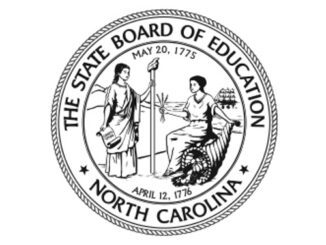
More than 1,500 students have enrolled or been offered seats at 10 new North Carolina charter schools expected to open this fall.
Enrollment numbers for these “Ready to Open” (RTO) schools were presented for the first time to the North Carolina Charter Schools Review Board (CSRB) on Monday, May 5.
If all 10 schools open as planned, 218 charter schools will operate statewide during the 2025-26 academic year, according to the Office of Charter Schools (OCS).
However, OCS data indicates that some schools face significant hurdles to opening this year, based on their current pace of enrollment. Six schools have not reached break-even enrollment numbers yet, and four still fall below the 80-student statutory minimum required to operate a charter school.
Just three schools — North Oak Academy, Liberty Charter Academy, and Carolina Achieve — account for nearly 1,000 of the students enrolled in the 10 new charter schools.
Ashley Baquero, the OCS director, told CSRB members at Monday’s meeting that a lot of the schools were listening online.
“If there’s anything that you look forward to seeing over the next month or any questions or advice you would give them… this is a great time to do that,” she said.
The CSRB offered counsel and warnings based on some of the schools’ enrollment challenges.
“The 80-student minimum is a bar that must be met,” CSRB Vice Chair John Eldridge emphasized. “If you don’t have 80 students, you can’t stay open.”
Enrollment minimums and break-even numbers
CSRB members expressed significant concerns about GO BIG Charlotte specifically. As of this month, just 28 students have enrolled in the all-girls charter school, according to OCS. GO BIG has already delayed opening twice.
“How long do we continue to work with a number of 28?” asked CSRB member Rita Haire. “That’s an indication when you talk about interest or demand or the market for something. And they’re still pushing forward.”
Another school, Triad International Studies Academy (TISA), is also under the statutory minimum, with 71 students enrolled. OCS is meeting with both GO BIG and TISA by May 15 to review next steps, said Natasha Norins, who works with the RTO schools at OCS.
OCS has the authority to grant a first-year delay for schools that want to wait. Subsequent delays, however, must be approved by the CSRB.
According to OCS, there are five schools in the current RTO cohort that previously delayed opening: GO BIG, North Oak Academy, Honor Preparatory, Agape Achievement Academy, and Nalanda Academy.
The chart below includes the new enrollment data on the 10 schools, including approved Average Daily Membership (ADM) for the first year, enrollment figures as of May, and break-even enrollment numbers. The OCS enrollment report for May enrollment data includes both “offered seats and fully enrolled students.”

During discussion, CSRB members talked about the potential for low enrollment to jeopardize the continuity of students’ education.
As a past example, Eldridge cited School of the Arts for Boys Academy (SABA), a former Chatham County charter school. In October 2023, the CSRB revoked SABA’s charter due to under-enrollment, directing the charter school to close in December. (SABA now operates as a private school, according to the school’s website.)
Disrupting students’ education through a mid-year closure “is just not a service to anyone,” Eldridge noted. However, he added, “At the end of the day, we will have to do what’s in the best interest of the students and the taxpayers of this state.”
Eldridge also cautioned new schools to plan for an enrollment cushion. Historical patterns indicate that 20% of currently enrolled students might not show up in the fall.
“If you’re looking to hit 80 students on your first day of school, you’re hoping that you’re at 100 students,” he said.
Norins said OCS had shared information about the 80-student minimum repeatedly with schools. However, many school board members and leaders, she said, are “optimistically hopeful.”
CSRB members also discussed budgetary implications for schools that have not met individual break-even enrollment numbers.
“That’s another signal for us to be really concerned that you’re going to be able to make a year-one budget work,” Eldridge said.
The CSRB will vote in June on whether to allow each of the 10 RTO schools to move forward. At that point, schools securing final CSRB approval will receive charter agreements signed by state Superintendent Mo Green.
Charter amendments for four schools
On Monday, the CSRB also approved amendment requests from four charter schools.
Franklin School of Innovation received approval for its request to participate in the National School Lunch Program.
Durham Charter School (DCS) secured approval for a relocation request. The school’s new campus is over five miles from its current location, so the move requires CSRB permission.
Former CSRB member Alex Quigley, DCS executive director, outlined the school’s plans.
“We are building a 50-acre campus” about 15 minutes from the current location, Quigley said. “The primary reason is we are now split between three facilities and have outgrown all three of them.”
DCS is seeing “a growing surge in interest” from the community, he said. “We are knocking on the door of 1,000 applications for about 300-350 available seats.”
“We’ll grow from 1,000 to 1,250 next year, and are projecting even more students than that,” Quigley added.
“This is one of the best charter schools that we have in the state of North Carolina, so the opportunity to have even more students to enroll… is good for those families,” said CSRB Chair Bruce Friend.

In addition, the CSRB approved multiple amendment requests from Liberty Charter Academy, one of the RTO schools.
Liberty Charter’s facility is zoned for K-8, so the school sought and secured CSRB permission to revise its K-9 grade-level plans and open with grades K-8 instead. Liberty Charter also received CSRB approval to reduce first-year enrollment projections from 645 to 500 students, open in an alternate location in 2025 if necessary, and launch ninth and 10th grades simultaneously in 2026.
Finally, Thomas Academy Charter School received CSRB approval for its grade-level expansion request to include grades 3-5 in 2025-26.
Located on the campus of the Boys and Girls Home of North Carolina in Lake Waccamaw, the school serves 71 middle and high school students. Thomas Academy had secured prior CSRB approval to operate below the minimum 80-student threshold, which statute permits if a school’s application offers a “compelling reason,” such as “a geographically remote and small student population.”
A “majority” of Thomas Academy students have “some history of trauma,” according to the school’s website. Thomas Academy provides therapeutic care along with instruction; some students live onsite at the Boys and Girls Home, while others come to Thomas Academy from the community.
New students in grades 3-5 are expected to represent a mix of community and residential students, said Dr. Cathy Gantz, the school’s principal. This will enable Thomas Academy to serve sibling groups living at the Boys and Girls Home, she added.
“I have visited the school, and I just want to thank you for what you do, Dr. Gantz. It’s a labor of love in that school, and you can see it when you visit,” said CSRB member Lindalyn Kakadelis.


